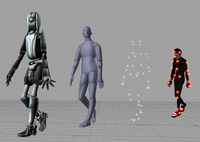
Photo from wikipedia
The vast amount of data captured by robots in large‐scale unstructured environments brings computation and storage problems to terrain modeling methods. Considering the practical terrain geometry structures, we design a… Click to show full abstract
The vast amount of data captured by robots in large‐scale unstructured environments brings computation and storage problems to terrain modeling methods. Considering the practical terrain geometry structures, we design a large‐scale terrain modeling framework for efficiently generating the compact and accurate terrain models from incomplete and uncertain measurements. The multiresolution elevation filtering is developed to generate terrain surfaces that preserve terrain details in the bumpy areas while achieving a sparse representation over the flat areas, which simultaneously reduces the computation time, storage space, and inference error. To further reduce the high computational complexity, we propose a computation decomposition strategy by adopting the Gaussian mixture model to partition the whole terrain surface into several subsurfaces, enabling the method to scale to much larger environments. For each subsurface, we train a Gaussian process model using the local data to adapt to the local terrain structure, concurrently resolving the data incompleteness and uncertainty. Furthermore, to provide a more informative terrain model, we efficiently derive terrain gradient through a closed‐form solution by treating the generated terrain models as continuous functions, enabling more robotics applications, such as the path planning. We perform extensive experiments to evaluate our framework, including the use of two medium‐sized terrain data sets to evaluate the overall and local performance, and two large‐scale glacier terrain and mountain terrain in the area of up to 9 km2 to validate the practical applications.
Journal Title: Journal of Field Robotics
Year Published: 2022
Link to full text (if available)
Share on Social Media: Sign Up to like & get
recommendations!